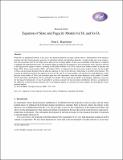| dc.contributor.author | Hagelstein, Peter L. | |
| dc.date.accessioned | 2019-10-16T19:38:56Z | |
| dc.date.available | 2019-10-16T19:38:56Z | |
| dc.date.issued | 2015-06 | |
| dc.identifier.issn | 2227-3123 | |
| dc.identifier.uri | https://hdl.handle.net/1721.1/122604 | |
| dc.description.abstract | When Pd is in equilibrium with H₂ or D₂ in gas, the chemical potentials are equal, and this allows a determination of the chemical potential and other thermodynamic properties of palladium hydride and palladium deuteride. At high loading near room temperature, the gas pressure must be very high, and an ideal gas law no longer applies. In this case a knowledge of the fugacity is required to interpret and understand the results. We examine empirical models for the equation of state and fugacity of H₂ which are relevant to the high pressure regime of interest, including an old model of Holley et al (1958), and the more modern models of Spycher and Reed (1988), Tkacz and Litwiniuk (2002), and Joubert (2010). At high pressure the more recent models are best, but the model of Tkacz and Litwiniuk diverges from the ideal gas equation of state at low pressure, which leads to an offset in the fugacity. We
examine the difference between the equation of states for H2 and D2 in recent models, and find that the small difference at high pressure in the models of Tkacz and Litwiniuk agree best with experiment, while the larger difference in the models of Joubert (2010) and Joubert and Thiebaut (2011) is probably not reliable. We examine the possibility of developing a difference correction for the fugacity theoretically. It may be possible to account accurately for the zero-point contribution; however, accounting for the difference in inter-molecular potentials due to the different degrees of rotational excitation requires the development of new potential models. | en_US |
| dc.language.iso | en | |
| dc.publisher | International Society of Condensed Matter Nuclear Scientists (ISCMNS) | en_US |
| dc.relation.isversionof | http://coldfusioncommunity.net/wp-content/uploads/2018/08/23_JCMNS-Vol16.pdf | en_US |
| dc.rights | Article is made available in accordance with the publisher's policy and may be subject to US copyright law. Please refer to the publisher's site for terms of use. | en_US |
| dc.source | Prof. Hagelstein | en_US |
| dc.title | Equation of State and Fugacity Models for H₂ and for D₂ | en_US |
| dc.type | Article | en_US |
| dc.identifier.citation | Hagelstein, Peter L. "Equation of State and Fugacity Models for H₂ and for D₂." Journal of Condensed Matter Nuclear Science 16 (June 2015): 23-45 © 2015 ISCMNS | en_US |
| dc.contributor.department | Massachusetts Institute of Technology. Department of Electrical Engineering and Computer Science | en_US |
| dc.relation.journal | Journal of Condensed Matter Nuclear Science | en_US |
| dc.eprint.version | Final published version | en_US |
| dc.type.uri | http://purl.org/eprint/type/JournalArticle | en_US |
| eprint.status | http://purl.org/eprint/status/PeerReviewed | en_US |
| dc.date.updated | 2019-10-10T14:38:50Z | |
| dspace.date.submission | 2019-10-10T14:38:51Z | |
| mit.journal.volume | 16 | en_US |
